#starlink satellites viewing
Explore tagged Tumblr posts
Text

Also saw this incredible meteor swarm. (I assume) I was looking up just enjoying the view while we got the telescope sorted, and i spotted this perfect line slowly trailing across the sky. You could see each dot individually even with the naked eye, and super clearly through binoculars. I've never seen anything like it.
EDIT: Turns out these are Starlink satellites!
20 notes
·
View notes
Text
There is much concern that Elon Musk’s Starlink intends to provide satellite internet coverage to the United States following the failure of its Red Sea “Operation Prosperity Guardian” alliance to curb Yemen’s pro-Palestinian front.
This conversation has gained traction since the company’s announcement on 18 September that it would launch services in Yemen after months of informal contracts with the Saudi-backed government in Aden. The timing of this announcement raised eyebrows, especially as it coincided with Israel’s terrorist attacks in Lebanon, involving exploding pagers and walkie-talkies.
[...]
The announcement that Yemen would be the first country in West Asia to have full access to its services surprised many – particularly because the US embassy in Yemen was quick to praise the move as an “achievement” that could unlock new opportunities.
[...]
The rival Sanaa government, under which most of Yemen’s population lives, was quick to warn that the Starlink project may threaten Yemen and its national security. Mohammed al-Bukhaiti, a member of Ansarallah’s political bureau, criticized the US embassy’s stance, which he says:
"Confirms the relationship between the launch of Starlink and the war launched by America on Yemen, which threatens to expand the conflict to the orbits of outer space for the first time in history."
[...]
In March, the Financial Times reported that the US and UK faced intelligence shortfalls in their Red Sea campaign, particularly around the capabilities of the Ansarallah-aligned forces’ arsenal. This intelligence gap underlined the west’s need for a reliable spy network, and Starlink’s role in this context raises serious questions.
A Reuters report revealed that SpaceX had signed secret contracts with the US Department of Defense aimed at developing a spy satellite system capable of detecting global threats in real-time.
[...]
Another concerning aspect is the involvement of Israel. Israel’s spy satellites, OFEK-13 and OFEK-14, are reportedly linked to Starlink’s satellite network. SpaceX, as a third party, may provide critical guidance and intelligence to these satellites, further enhancing Tel Aviv’s surveillance capabilities in the region. This connection between Starlink and Israeli intelligence efforts has heightened fears in Yemen that the satellite network will be used to undermine the country’s security and sovereignty.
Currently, Starlink services are available primarily in Yemeni areas controlled by the Saudi and UAE-led coalition, although roaming packages allow temporary access in other regions. This has prompted concerns about data security, privacy, and the spread of misinformation, as unrestricted satellite internet bypasses local government control.
[...]
Moreover, cybersecurity risks are particularly troubling, as the network might be exploited for dangerous purposes, including facilitating terrorist activities like bombings. The presence of a global satellite internet service that bypasses local regulations raises concerns about its potential to disrupt local internet infrastructure.
Starlink could also introduce unfair competition to local provider Yemen Net, further marginalizing the national telecom provider and hindering local development efforts.
[...]
Dr Youssef al-Hadri, a right-wing political affairs researcher, shared his views with The Cradle on the recent events in Lebanon and the ongoing electronic warfare involving the US and its allies. According to Hadri, intelligence agencies operating in areas under the control of the Sanaa government face challenges in detecting the locations of missiles, drones, and military manufacturing sites.
This shortfall became even more apparent after a major intelligence operation exposed a long-running spy cell in Yemen, with activities spanning across multiple sectors.
From the risk of espionage to the undermining of local telecom providers, the implications of Starlink’s operations extend far beyond providing internet access – they could become a vehicle for foreign influence and control.
[...]
3 Oct 2024
13 notes
·
View notes
Text
Brian Stelter at CNN Business:
New YorkCNN — President-elect Donald Trump’s pick for chairman of the Federal Communications Commission, Brendan Carr, wasted no time in stating his priorities on Sunday night. Just one hour after thanking the president for the appointment, Carr wrote on X, “We must dismantle the censorship cartel and restore free speech rights for everyday Americans.” Carr and Trump’s powerful ally Elon Musk immediately replied with one word of affirmation: “Based.” The comments from Carr, who wrote the chapter on the FCC in the conservative blueprint Project 2025, signaled that it won’t be business-as-usual at the country’s communications regulatory agency. Past chairs of the agency, both Republicans and Democrats, have emphasized broadband internet deployment and wireless spectrum policy. Carr didn’t mention those issues on Sunday night.
Instead, he took aim at technology companies for “censorship;” promised to hold broadcast TV and radio stations accountable; and pledged to end the FCC’s promotion of diversity, equity, and inclusion efforts. Carr was very clearly channeling the president-elect, who raised all three topics on the campaign trail, often in misleading ways. Trump appointed Carr to the FCC in 2017. Carr is now the senior Republican at the agency, which meant he was widely expected to get the chairman appointment. He also has a close relationship with Musk (some of it has been visible in their interactions on X) and has accused Democrats of waging “regulatory lawfare” against Musk’s Starlink satellite internet service.
As chairman, Carr may be able to steer generous federal subsidies to Starlink. When Politico published a story titled “the DC bureaucrat who could deliver billions to Elon Musk” last month, Carr told the outlet that he would be an even-handed regulator. Musk celebrated Carr’s appointment on X on Sunday night. Both men talk in much the same way about free speech rights, reflecting widespread concerns on the right about online censorship. (Trump called Carr “a warrior for Free Speech” in the press release about his appointment.) Claims of conservative censorship erupted several years ago as a result of content moderation decisions by social media platforms like Facebook and Twitter. Officials at the platforms said they were acting in good faith to reduce some of the toxicity – like election lies and Covid pandemic conspiracy theories – that turned off many users. Conservatives charged that the platforms were unfairly silencing their views – factoring into Musk’s decision to buy Twitter and turn it into X.
[...]
In his Project 2025 chapter, Carr laid out an agenda for the federal agency under a future Trump administration. The agency’s top priorities, he wrote, should be “reining in Big Tech, promoting national security, unleashing economic prosperity, and ensuring FCC accountability and good governance.”
In the chapter, Carr also asserted that the Chinese social media platform TikTok “poses a serious and unacceptable risk to America’s national security” and should be banned. Carr’s years-long crusade against TikTok paralleled Trump’s calls, although Trump reversed his position on TikTok earlier this year. Carr has also supported the rollback of net neutrality rules and called for “legislation that scraps” Section 230 of the Communications Decency Act, which gives immunity to tech platforms that moderate user-generated content. “Congress should do so by ensuring that Internet companies no longer have carte blanche to censor protected speech while maintaining their Section 230 protections,” he wrote in Project 2025. The FCC does have jurisdiction over local TV and radio licenses. During his reelection campaign, Trump called for every major American TV news network to be punished, often because of interview questions he disliked or programming he detested. He repeatedly said that certain licenses should be revoked – usually while misstating how the licensing process actually works.
The FCC grants eight-year license terms and hasn’t denied any license renewal in decades. But Carr indicated earlier this month that he would take Trump’s complaints seriously. And he wrote on X Sunday night that “broadcast media have had the privilege of using a scarce and valuable public resource — our airwaves. In turn, they are required by law to operate in the public interest.” As chairman, he added, “the FCC will enforce this public interest obligation.”
Donald Trump taps Project 2025 co-writer Brendan Carr to head the FCC for his 2nd term.
The FCC under Carr’s leadership will be a clearinghouse for far-right items, such as protecting far-right misinformation and disinformation from “censorship”, revoke broadcasting licenses from anti-Trump outlets, and more.
See Also:
Mother Jones: Trump’s FCC Pick Wants to Intimidate Broadcasters and Enrich Trump Allies
9 notes
·
View notes
Text
9 notes
·
View notes
Text
Did I See Santa?
In the 1990s, the idea of something like Starlink—a network of satellites flying in formation—was purely speculative. Yet, in 1993, I had an experience that felt eerily similar to what one might describe today when recounting a sighting of those satellites. That year, I was on a memorable Christmas shopping trip with my half-brothers, who were much older but never felt like anything but brothers…

View On WordPress
4 notes
·
View notes
Text

Character Limit by Kate Conger and Ryan Mac
Behind the scenes of a corporate acquisition that changed social media for ever
There was a time, just three or four years ago, when you could follow the news closely and not hear about Elon Musk for days – or even weeks. He was well on his way to becoming the world’s richest man, and was already a polarising figure, but he was a missable one. Those days are long gone.
Musk is now locked in a fierce public battle with the government and judicial system of Brazil, in the name of free speech, after he refused a court order to block several accounts that were accused of spreading hate speech and disinformation. He is a key figure in the US election race, having been lined up for a job finding savings in government spending should Donald Trump – who he has endorsed – win the presidency. Thanks to his Starlink satellites, he is a critical figure in the balance of power between Russia and Ukraine.
Musk is a powerful man because of his wealth and his control of strategic industries, including space launch and satellites. But he is inescapable because of the social network he took over and then transformed: Twitter.
Even people who never used Twitter more or less know its story over the last few years: Musk bought it, gave it a juvenile new name, X, and the whole thing seems to have been a complete mess that has made everyone miserable, including Musk himself.
That makes the job of New York Times reporters Kate Conger and Ryan Mac in their chronicle of the takeover and its resulting fallout, a difficult one: almost anyone who might actually read this book is pretty familiar with how things have played out. How can you make a story compelling when each step along the way has already been so heavily covered?
Conger and Mac’s answer to that is their astonishing ability to take the reader into almost every room that mattered during the contentious $44bn acquisition. The book opens with a Twitter data scientist getting ready to meet Musk, ostensibly in a bid to keep his job. The employee, however, has already decided he’s quitting and is instead using the opportunity to level with the new boss. The encounter goes predictably badly, leading him to accuse Musk of being one of the most gullible men on the planet. The book records Musk’s response as being two words long: “Fuck you.”
At other moments, the narration seems to know Musk’s exact movements when he was at home with his then-girlfriend Claire Elise Boucher (better known as the musician Grimes), or the conversations that take place on his plane. Such is the apparent omniscience that impressive accounts of goings-on in boardrooms and executive suites during the takeover seem par for the course.
Musk himself did not grant the authors an interview. Some of their insights come from court documents and other reporting, but there is no doubt that Conger and Mac enjoyed unmatched access to a range of characters from all sides. You couldn’t hope for a better ringside seat on the unfolding drama.
This closeup view is rarely flattering. Twitter’s co-founder, Jack Dorsey, comes across first as flighty and disengaged, then outright sulky as he is eased out as Twitter’s CEO – before himself joining Musk on the radical right. By the time we leave him, “his online posts were the kinds of things he would have had labelled or removed while he was Twitter’s CEO”. Musk’s authorised biographer, Walter Isaacson, seems to jump from observer to participant. Not only does he reportedly advise Elon Musk on the price point for his ill-fated plan to sell Twitter verification – the fabled “blue tick” – but apparently tells Musk to drop labels “for all media”.
Heroism, where it comes, centres on efforts to keep datacentres online, or to keep a moderation team in their jobs for another day or two to cover elections in the US and Brazil. Some characters are more sympathetic than others, but there are few good guys here – Character Limit is the story of a dysfunctional company becoming a shambolic one.
All of this makes for compelling reading, perhaps compelling enough to keep even people used to X’s 280-character-long posts engaged for a 430-page book, which is surely no small feat. Those who have followed the story obsessively will find plenty of nuggets to keep them interested if they can get past the somewhat stodgy first third of the book. Casual observers, who will probably have already had their fill from the endless news reporting on Musk’s antics, might find it harder going.
One of Conger and Mac’s challenges is that they are telling a story without an ending. X might go bust within the next year, or prove decisive in the 2024 presidential race. It could easily do both. In fact, the stately speed of book publishing means that Character Limit’s narrative has already been overtaken by events. As a retelling of exactly what happened and what it felt like to be there, it is a triumph. Anyone hoping for insights into what it all means, or what might happen next, will need to look elsewhere.
Musk’s companies have put more rockets into space this year than every government on the planet combined. He has businesses developing artificial intelligence, human-machine interfaces, self-driving vehicles, and more. A book with unprecedented access to his circle portrays him as a man with no impulse control, no plans, a desperate need for flattery and no ability to separate truth from fiction. If it leaves open the question of why he does what he does, and what he’ll do next, that may be because no one – least of all Musk – really knows.
Daily inspiration. Discover more photos at Just for Books…?
5 notes
·
View notes
Text
At 6:26, me and my friend T were out on a walk. We love to go out on random night walks like that, and talk about things like psychology and astronomy. I believe we were talking about Doctor Who, or something similar until we got to the intersection of two roads. We didn't normally go that way, but then again, we always choose a different route, and this one was in the direction of another friend's house. Before I describe what we saw, I must clarify that me and T have never done drugs, and were not on any drugs other than normal prescriptions. I'm straight edge, and we often joke about how talking about the joys of life is our drug.
With that out of the way, what me and T saw when we looked up appeared to be a string of multicolored lights, huge and looking above us. It was gently revolving. I started at it, and said something like "No no no no no" while stepping away. T said something reassuring, like comparing this to a sci-fi plot, as she often views things as a story. I, on the other hand, kept my eyes fixed on the bright series of shapes for more than ten seconds. I remember it having a distinct contour, almost like a giant saucer spinning in the sky. It had dark dark shadows, and peircing multicolored lights. I am so glad I write, so I can attempt to properly describe what I saw as closely as I actually saw it.
After seeing this spinning caurosel-like shape in the sky, Remembering the rule that no one ever gets photos of the bizzare things they see, I immediately decided to take what I thought to be a clear photo of the event (pictured below),
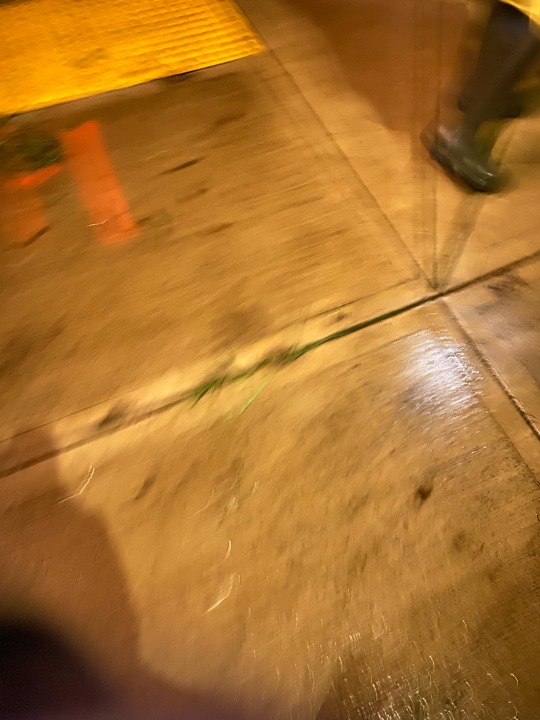
Before urging T for us to go home. On the way home, I called my boyfriend, while he and T attempted to calm me down. I felt like my entire grip on reality had just been lost. While on call, T said they wanted to go back if I was alright with it. They later said they saw it dissapear behind the trees as we were walking away, and they wanted to see if it was still there so they could further examine it. While still having my boyfriend calling down, we walled back to where we were. I had a bit of a panic spiral, and we went back home. I told my dad, and he was like "oh it's no big deal". I continued to freak out, so T suggested we watched another episode of Doctor Who to calm me down. Halfway through an episode, I couldn't stop thinking about it. I brought it up, and they remembered we should probably describe what we saw.
Their recollection is on the left, mins is on the right. Note: the contour was not as strong as I depicted it, accidentally I added more lines than necessitary.
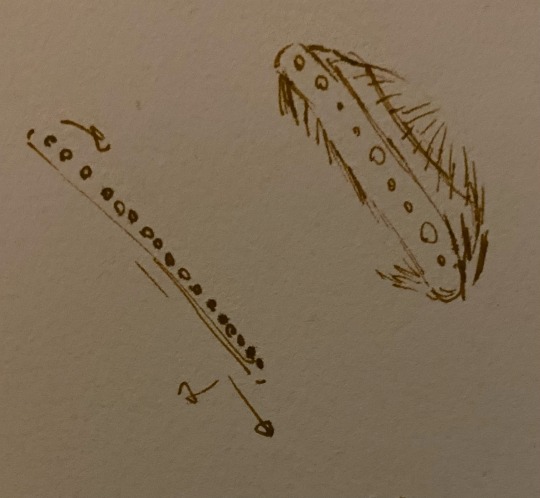
They added lines to show how it revolved. These are further drawings I did while watching the show. Left is the most accurate according to my memory.

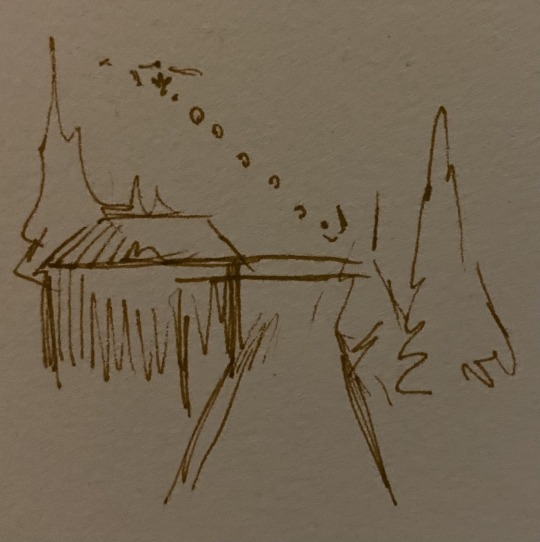
I would normally remain skeptical, and I am trying to remain skeptical, but the fact we BOTH saw it in front of us can at least (mostly) disapprove it being a hallucination or trick of the eye. I just know that we at least saw SOMETHING. I have gotten so stressed out over this that I am physically tired, and have gotten a headache.
What I saw appeared to be impossible. I'm questioning a lot of things right now. It looked so big, so vast, and why was it here in the first place? Was it earth technology? I have no fucking clue and I am scared
God, I wish I wasn't an alien nerd so this sounded more believable.
Oh yeah, and the Starlink satellites are currently in Canada, nowhere near where I live.
Additional notes/corrections by T available in the comments on this post.
9 notes
·
View notes
Text

My first ever viewing of a Starlink satellite chain, photographed flying over central Alberta last night.
I know the novelty will wear out fast; for many (especially astronomers) it already has. But on viewing for the first time they are undeniably cool and sci-fi looking. Plus I've yet to see an actual UFO so the experience of seeing these things suddenly appear is perhaps the next-best thing.
3 notes
·
View notes
Text
SpaceX Starlink 6-43 Set To Launch Sunday Evening
Booster B1077 prior to its last launch, North Grumman NG-20Photo: Charles Boyer / FMN SpaceX plans to launch the Starlink 6-43 mission Sunday, March 10 aboard a Falcon 9 rocket. The payload will be another tranche of 23 Starlink satellites that will be ferried low-Earth orbit from Space Launch Complex 40 (SLC-40) at Cape Canaveral Space Force Station in Florida. According to the company,…

View On WordPress
4 notes
·
View notes
Text
Elon Musk 'Committing Evil' By Blocking Internet Access, Top Ukrainian Advisor Says
WASHINGTON (Reuters) – Elon Musk said he refused a Ukrainian request to activate his Starlink satellite network in Crimea’s port city of Sevastopol last year to aid an attack on Russia’s fleet there, saying he feared complicity in a “major” act of war. The billionaire businessman made the comment on his social media platform X after CNN cited a excerpt from a new biography of Musk that says he…

View On WordPress
8 notes
·
View notes
Text
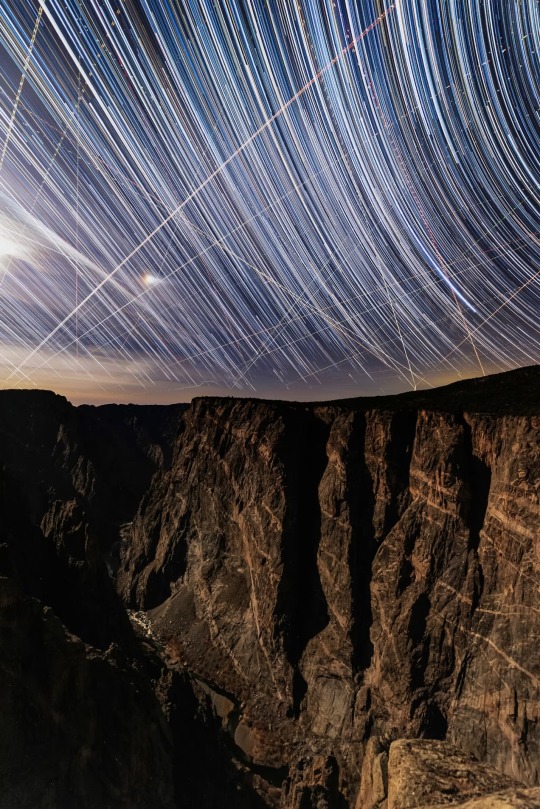
This long exposure photo of the sky above Gunnison National Park in Colorado shows the movement of light—coming from both natural and artificial sources. The thousands of satellites in orbit around the earth can shine millions of times brighter than objects farther away in space, getting in the way of astronomic observations. Photograph By Babak Tafreshi
It Looked Like A Bizarre Alignment of Meteors. It Was Something Else.
Astronomers are calling arrays of thousands of Satellites, like that of Starlink’s, “Mega Constellations” because of their overwhelming presence in the night sky.
— By Terry Ward | August 11, 2023
A fleet of UFOs, a bizarre alignment of meteors, a drone show: These are just a few of the things SpaceX’s Starlink satellites have been mistaken for of late.
National Geographic photographer Babak Tafreshi, however, knew exactly what he was seeing on a recent July evening in California’s Pinnacles National Park, when a “caravan of satellites” paraded across the sky, aligned as if they were perfectly-spaced stars.
“I see them very often because there are just so many of them,” he says. “People react because they have no idea what it is.”
These satellites bring broadband internet to some of the planet’s most remote reaches. They are usually seen in low-earth orbit (around 186 miles from ground) on their way up to their final orbit at 342 miles high. As they rise, they grow dimmer and spread out until they’re mostly out of sight of the naked eye, which can take up to several weeks. Astronomers call these massive arrays of satellites “mega constellations.”
In recent months, these satellites are being launched more frequently, often with over 50 satellites at a time, by Elon Musk’s commercial space company. Sightings of Starlink mega constellations are also becoming more common, says David J. Helfand, a professor of Astronomy at Columbia University.
The satellites are making it much more difficult for astronomers to do their jobs, he says. “When a satellite goes through the field of view of a telescope, it’s extremely bright,” Helfand says. “The objects we’re trying to study–distant galaxies and stars–are 20 million times fainter than satellites. So when one of these streaks goes across the image, it completely obliterates the image.”
At least 6 percent of the 2021 images from the Hubble Space Telescope were “compromised or completely ruined” by satellite interference by Starlink satellites, he says. “That’s when there were only 1,500 Starlink satellites…Now there are three times that amount.” And many more are on the way.
Satellites: An Invaluable Tool, An Astronomic Obstacle
In a February press release, SpaceX said they’d launched “nearly 4,000 satellites” over the last five years. They aim to send up to 42,000 satellites into its mega constellation in coming years, according to Space.com. SpaceX did not respond to National Geographic’s request for comment.
These satellites can be seen with the naked eye in the days following their launch (when their orbit is lower to Earth and satellites are still close enough together to appear in a line), and in the hours just after sunset and just before sunrise. Websites like Heavens-Above.com predict when Starlink satellite trains will pass overhead for people looking to spot them.
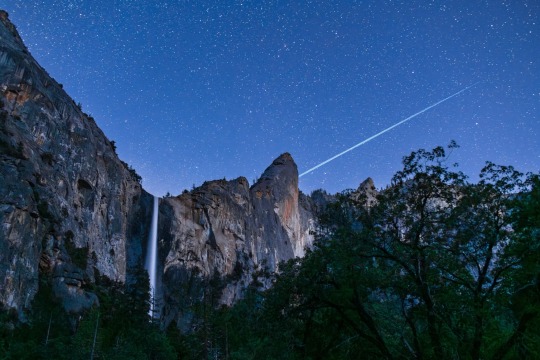
Starlink satellites travel across the night sky above Yosemite National Park, California. Photograph By Babak Tafreshi
Satellites like Starlink’s have long been used to enhance mobile services like cell phone coverage, internet and GPS navigation for people on Earth. Satellites also make weather forecasting, TV signaling, radio, and military surveillance possible.
But before Starlink launches, there were no “trains of satellites” to be seen, says Tafreshi. SpaceX uses new satellites that can be folded up in the dozens and sent into space on private rocket launches out of Cape Canaveral in Florida and Vandenberg Space Force Base in California.
“You used to see a couple of satellites at the beginning of the night and it was very cool to see a ‘moving star’ in the sky,” Tafreshi says. “Now, every direction you look there are a few moving above you. They’ve stolen the show from the stars.”
While Starlink satellites in low-earth orbit aren’t the brightest man-made objects in the sky, it’s the sheer number of them that’s worrying, says James Lowenthal, professor of astronomy at Smith College. “Starlink’s appear very bright when they're first launched into low orbit—brighter than the great majority of naked-eye stars,” he says. They become fainter as they are both moved to higher orbit as well as actively controlled to face certain directions–primarily for their own communication, but in part to make them appear dimmer, too.
Other companies with mega constellation projects in the works include Amazon’s Project Kuiper, currently planning a mega constellation of 3,236 satellites for broadband internet purposes. AST SpaceMobile’s BlueWalker 3 will start with 100 satellites and they may be brighter than 99.8 percent of visible stars, according to New Scientist.
Regulating Our Skyscape
When Lowenthal witnessed Starlink’s first satellite launch in 2019, he says he knew “the sky would never be the same again.”
A lack of international regulation and environmental oversight is endangering the sanctity of our skies like never before, says Aparna Venkatesan, a professor in the department of physics and astronomy at the University of San Francisco.
"We have no framework in place to conduct environmental assessments of all phases of satellite constellations, from launches to in-orbit operation to decommissioning,” she says.
Thousands of satellites break down in the atmosphere, leaving an estimated million pieces of space debris “criss-crossing at high relative speeds” and increasing the chance of collision with other space crafts, a 2021 paper asserts. These rockets also leave behind sooty discharge called black carbon, which could cause “changes in the global atmospheric circulation and distributions of ozone and temperature,” according to a 2010 paper.
Satellites contribute to light pollution by reflecting the sun’s light and also by their sheer numbers. Dark Skies organizations are fighting to minimize artificial light at night both to protect local ecosystems, and also to respect communities whose identities are closely tied to the night sky.
“Rapidly growing ground- and space-based light pollution is erasing Indigenous stories and identities—again—as history is painfully repeated for marginalized communities already disproportionately impacted by climate change and other crises,” Venkatesan says.
SpaceX has “done some due diligence,” says Vishnu Reddy, director of the Space4 Center at the University of Arizona, which measures the brightness of Starlink mega constellations and their impacts on ground-based astronomy.
Newer Starlink satellites “don’t reflect as much,” as the first generation satellites from 2019 and 2020, Reddy says, and some older ones have also been “deorbited‚”—falling out of orbit and burning up in the atmosphere.
Lowenthal agrees that SpaceX “quickly heard the alarm from astronomers around the world,” engaging in conversations with astronomers from the company’s first Starlink launch. “What they haven’t done, however, is slow down launches,” he says. “We have always relied on our ability to turn to the night sky for solace and personal connection as well as scientific study…that’s all threatened.”
#Meteors#Bizarre Alignment#Mega Constellations 🌌#Starlink#Satellites 🛰️ 📡#Skyscape#Astronomic Obstacle#Terry Ward#National Geographic
2 notes
·
View notes
Text
T-Mobile Starlink is now free in the U.S. until July
T-Mobile took advantage of the Super Bowl to announce that its T-Mobile Starlink beta service is now available to everyone in the U.S. – yes, anyone can sign up. So, what exactly is T-Mobile Starlink? It’s a service, created in partnership with SpaceX’s Starlink, that extends cell coverage to 500,000 square miles in the U.S. where no cell towers exist. You don’t need a special satellite phone;…

View On WordPress
0 notes
Text
It-Mobile and Starlink Satellite is specified
Calvin gave up / Android Republic In August 2022, the T-Mobiles and Scecx has announced a strategy to expand the mobile episode in the US with the help of the lowest sapellites. Fast to 2025, and T-Mobile Starlink service now to roll out To everyone, AT & T and verizon users. It-Mobile says its Satellite service increased to connecting to more than 500,000 miles of the US without a custom.…

View On WordPress
0 notes
Text
Apple and SpaceX Partner to Bring Starlink Connectivity to iPhone
Apple, SpaceX, and T-Mobile have joined forces to integrate Starlink satellite connectivity into iPhones through iOS 18.3. The beta testing phase has already begun in the United States, involving a select group of users. Apple Inc. has been secretly collaborating with SpaceX and T-Mobile US Inc. to enable Starlink network support on iPhones, offering an alternative to Apple’s own satellite…

View On WordPress
0 notes
Text
Elon Musk's Starlink Reportedly Submits Formal Acceptance of Licence Norms, Could Launch in India Soon
Starlink has formally accepted the security and data storage requirements set by the government of India for all prospective satellite broadband service providers seeking a licence to operate in the country, according to a report. The Elon Musk-led satellite internet firm is looking to launch its services in India, where satellite spectrum is expected to be allocated administratively. It is…

View On WordPress
0 notes
Text
0 notes